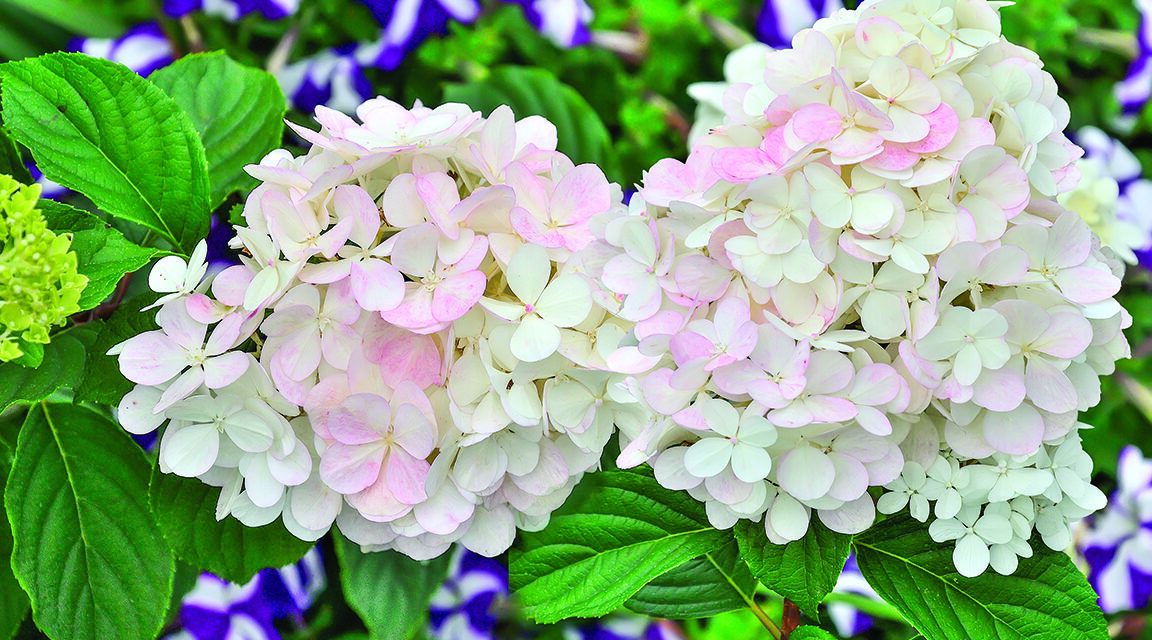
Viburnum is mainly the “queen of spring,” flowering April through May, but there may be a flash of flowers in the fall.
With similar clusters of showy white flowerheads, several popular home garden woody shrub landscape plants are commonly called “Snowball” bushes.
Horticultural professionals can help untangle the confusion, but to do so they need to introduce scientific names to help sort things out.
Dr. Lisa Alexander, a USDA research geneticist with the U.S. National Arboretum, explained that the look-alikes belong to different plant families, bloom during different seasons, and grow into different sized specimens.
The two separate plant groups in the discussion are viburnum and hydrangea, notably, Viburnum macrocephalum and Hydrangea arborescence.
“What’s hard for scientists is to hear terms like snowball bush, because just with viburnum, there are several species that people refer to as ‘snowballs,’ Alexander said. “All are pretty similar, and natives of China and Japan, but all got the common name of snowball viburnum, so they’re hard to distinguish.”
While online trade nurseries market various viburnum cultivars including Viburnum opulus (Chinese snowball) and Viburnum plicatum (Japanese snowball), the most common home garden variety appears to be Viburnum macrocephalum, she noted.
To further muddle the landscape, the native Smooth Hydrangea, scientifically identified as Hydrangea arborescence, is also popularly thought of as a snowball bush.
Here, too, though, it’s not that simple, Alexander said.
“Due to having the biggest mophead flowers, Annabelle is the best known among many cultivars of Hydrangea arborescence,” so people tend to ask for Annabelle when referring to other varieties, she added. Closing in on popularity is Incrediball, whose stronger stems safely hold up the heavy flowers in sturdier fashion, preventing post rain “flower flop,” Alexander mentioned. Incrediball Blush and Invincibelle offer pink floral clusters.)
“We’re taught not to use scientific language with lay people but sometimes you do have to at least establish a base of what plant are we actually talking about here,” Alexander laughed.
To understand whether your so-called snowball bush is a viburnum or hydrangea, just check its growing habits, Alexander advised.
“Viburnum is mainly the queen of spring, flowering April to May, but there may be a flash of flowers in the fall. It’s a nice showpiece to fill the niche between bloom time of daffodils and summer flowers,” she advised. “Hydrangea arborescence, meanwhile, bloom from June through the Fall frost.”
“Both like partial shade and protection from afternoon sun, but for hydrangea, it’s a must,” Alexander noted, as the higher heat affects them more.
“The word ‘hydrangea’ basically means moisture loving,” she said. “Unless they’re in a moist spot, and even then, they must have some afternoon sun protection or get supplemental irrigation in the hot weather because they will flag and quit producing as much. Viburnums are much more forgiving of a little bit of drought and extra sun.”
Through its ongoing internal research and development, the National Arboretum has made available a newer snowball Viburnum named “Nantucket,” well suited to better withstand the higher temperatures of the Southeast and Mid-Atlantic, offered patent free through trade nurseries and by contacting the Arboretum, Alexander mentioned.
Another crucial differential involves pruning. “Viburnum produce their flower buds on old wood, while Hydrangea produce on new growth,” she said. “That means, with Viburnum, if it blooms April through May, you need to prune in June (maybe July), as soon as the flowers are done.
“But don’t wait past August, because fall is when the buds set for next year. If you prune mid-Winter or early Spring, you’re pruning off all your flower buds” which explains why some Viburnum don’t flower, Alexander explained.
Though most people prune Hydrangea in fall, late winter or early spring, it can be done anytime throughout the growing season, due to its blooming on new wood growth, she added.
Another vital factor to keep in mind is size. “Viburnum gets much bigger, becoming like a small tree, while Hydrangea remains a more compact shrub,” Alexander cautioned, advising gardeners to know which specific snowball bush they’re selecting a site for when planting.
According to the New Jersey Agricultural Experiment Station’s fact sheet on Hydrangeas in the Garden, the Smooth Hydrangea grows 3 to 5 feet tall with an equal or greater spread. Foliage ranges from 2 to 6 inches long and is dark green on top, green, pale green, or silver below.
The Virginia Cooperative Extension meanwhile lists Viburnum macrocephalum among its shrubs growing over 9 feet tall, describing it as a “hydrangea on steroids.”
Another characteristic a gardener might want to be aware of is native vs. non-native.
The Smooth Hydrangea is native to the Eastern United States. Also, its bulky flowerheads feature very few fertile pollen producing parts, densely covered with sterile florets. Alexander further explained the phenomenon.
“It’s been my experience as a hydrangea breeder, the bigger and denser the white showy florets are, the more dark, warm suffocating the environment for the fertile flowers is, so they don’t really produce much pollen, because they’re crowded out under there,” she noted.
While Vibernum macrocephalum is not native, the very small amount of fruit produced (relative to the overall 150 species of Viburnum) is mostly sterile, Alexander added.
However, ecologist Sylvan Kaufman, Science Advisor to Adkins Arboretum in Ridgley, urged gardeners to be extra careful in selecting Vibernum overall, due to their prolific growth.
Kaufman, who co-authored with her father Wallace Kaufman the book Invasive Plants: Guide to Identification and the Impacts and Control of Common North American Species (Stackpole Books, 2013), also wrote about the concerns some ecologists have about several varieties of Snowball Viburnum, in an April 2017 article for the Maryland Invasives Species Council, which designated them “Invader of the Month.”
One of these is Vibernum plicatum, or Japanese snowball, introduced originally in the United States starting in the 1800s.
Though planted within the confines of botanic gardens, several of the snowball varieties “escaped.”
Growing readily, the potential for rapid spread has raised red flags among natural area managers, concerned that it can overwhelm native plants’ ability to flourish, and thereby diminish them.
Kaufman recommends that Mid-Atlantic gardeners seek out several native Viburnum varieties available, including, the smallest, Viburnum arrowwood (V. dentatum), Viburnum possumhaw (V. nudum), and Viburnum mapleleaf (V. acerifolium), and, among the largest, Viburnum blackhaw (V. prunifolium).
These also offer striking colors, especially into the fall, she added.





